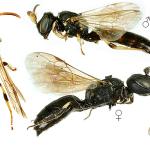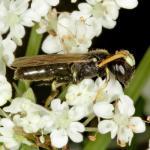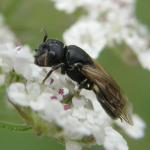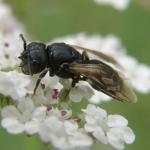Hylaeus plantaris SMITH 1842; Hylaeus plumicornis COSTA 1884
Unique among British bees in carrying at least part of the pollen load in a shallow depression on the lower part of the face, the depression being bounded on each side by a usually prominent blunt process (hence the origin of its specific name).
Southern England, from East Devon to Kent, northwards to Wiltshire, Berkshire, Warwickshire, Oxfordshire, Northamptonshire, Cambridgeshire, Suffolk and Norfolk. There are no records from Ireland. Generally a rare species, though in recent years there has been a noticeable increase of records from various sites within its range. A similar increase has been noted in Holland (Koster, 1986b). Widely distributed in central and southern Europe, north Africa, Anatolia and the Caucasus (see distribution maps in Koster, 1986a and 1986b).
Provisionally listed as a Rare species (pRDB3) by Falk (1991).
Includes open deciduous woodland, fenland and, especially, calcareous grassland.
Univoltine; early June to late August. Females, as with other British Hylaeus species, appear to be long-lived, in contrast to the males which are only found close to the beginning of the flight period.
Nests have been rarely found. One was in a dead dock (Rumex) stem (Smith, 1855) and another in a dead wild parsnip (Pastinaca sativa) stem (specimen in the University Museum, Cambridge). It also nests in herbaceous stems on the continent (Janvier, 1972; Koster, 1986a).
Wild mignonette (Reseda lutea), lesser stitchwort (Stellaria graminea), field scabious (Knautia arvensis), yarrow (Achillea millefolium), angelica (Angelica sylvestris), hogweed (Heracleum sphondylium), wild carrot (Daucus carota) and ox-eye daisy (Leucanthemum vulgare). Pre-mating has been observed on the inflorescences of hogweed (Heracleum sphondylium)(Morris, 1992), and a coupled pair has been observed on wild carrot (Daucus carota) (G R Else, pers. obs.).
No information available.
2001
Proofed: January 2012





